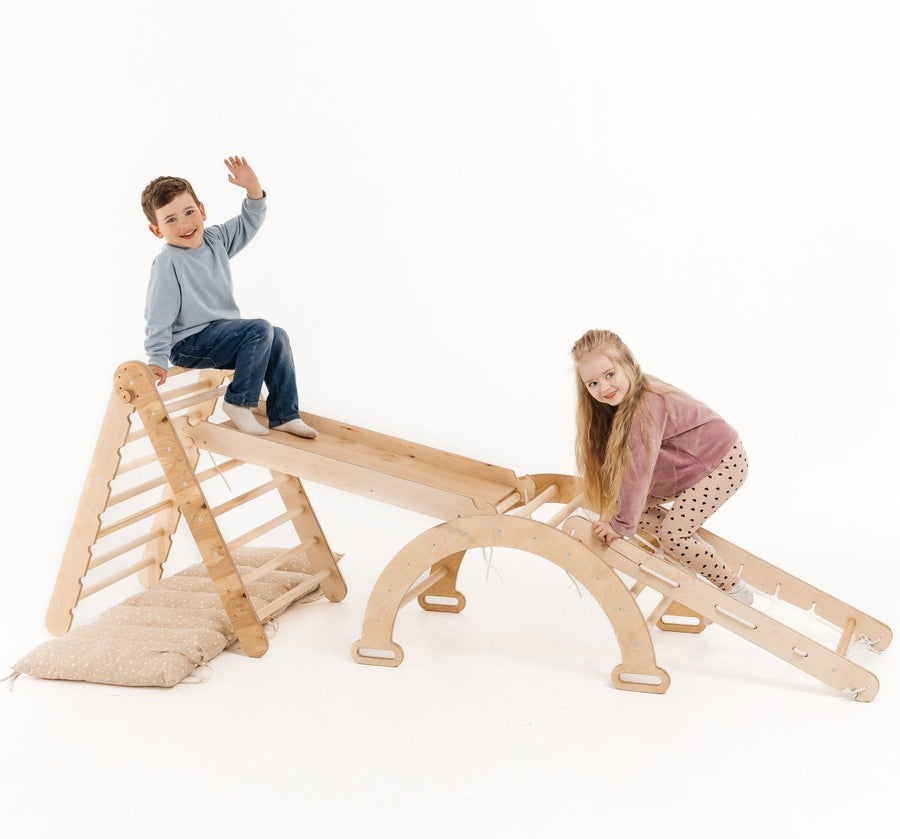How Montessori toys contribute to the development of creative thinking and imagination?
Understanding the Montessori Philosophy
The Montessori philosophy, first established by Dr. Maria Montessori over a century ago, centres around cultivating a child’s innate drive to learn and grow. It's a holistic educational approach that respects and nurtures the individuality of each child. The central tenet of this philosophy is that children are naturally eager to learn and will thrive in an environment where they can engage in self-directed, purposeful activities.
At the heart of the Montessori approach is the ‘prepared environment’. The goal of this environment is to facilitate independent exploration and learning. It's filled with developmentally appropriate materials that are aesthetically pleasing and inviting to the child. Each item serves a specific purpose and is designed to meet the child at their current level of development, providing just the right amount of challenge.
The Montessori method fosters an appreciation for learning by providing children with the freedom to follow their curiosity and interests, cultivating a love for knowledge that extends far beyond the confines of the classroom. The role of the adult in this environment is not to instruct, but to guide and facilitate, creating a supportive atmosphere that encourages exploration, fosters independence, and cultivates creativity.
Ultimately, the Montessori philosophy is about more than education - it's about nurturing the whole child by honouring their unique pace and learning style. This balanced approach to development sets the foundation for a lifelong love of learning, promoting not just academic success, but also a deep sense of self-awareness, confidence, and resilience.

Source: Motherhoodcommunity.com
Montessori Toys: Tools for Creative Exploration
The philosophy Behind the Design
Montessori toys are unique in their ability to ignite children's inquisitiveness and foster their creative thinking. These toys stand apart from traditional playthings in their purposeful design and focus on sensory-motor development. Unlike conventional toys that might dictate how a child should play, Montessori toys are minimalist and open-ended. The simplicity of the toys is intentional, providing less structure and more space for creative thinking. They're designed to match a child's developmental stage, from colour-matching toys for toddlers to more complex puzzles for older children.
Unleashing Creative Expression
The open-ended nature of Montessori toys offers children a platform to become storytellers, inventors, and artists, actively constructing their narratives. With each creation, they are creating a story, setting roles, and expressing their unique understanding of the world. This narrative play fosters language development, storytelling skills, and creative thinking.
Promoting Artistic Expression
Artistic expression is another facet of creative exploration that Montessori toys nurture. For example, pattern blocks can be used for more than just geometric discovery—they can be the palette for creating a unique mosaic or abstract artwork. As children manipulate these blocks of various shapes and colours, they learn about symmetry, enhancing their artistic skills and aesthetic appreciation. Additionally, the Art Add-on to the triangle ladder presents an ideal tool for children to further express their creativity. This multifunctional art station acts as a mobile atelier, offering the versatility of an adjustable table and an easel in one. Young artists can use it as a canvas for their imaginations, whether they are drawing, writing, or even crafting a toy-centric storyline. Its attachable design to both a triangle ladder or a climbing wall transforms any space into an artistic playground, promoting flexibility in learning and creativity, wherever they choose to be.

Source: Goodevas.com
Independence and Self-Correction
Montessori toys are also often designed for independent use and self-correction, meaning children choose what they want to play with, how they want to play with it, and the pace at which they engage with it. As a result, a child can check their work and learn from their errors without adult intervention. By figuring out where they went wrong and how to correct it, children engage in critical thinking, which is a vital aspect of creativity. This freedom is crucial in fostering imagination. When children direct their own play, they immerse themselves in their own worlds of wonder, allowing their dreams and ideas to guide their actions.
Nurturing the Imagination Through Montessori Play
Learning Through Role-Playing
Central to Montessori-inspired play, role-playing serves as a powerful catalyst, sparking a child's imagination to bloom freely. The allure of this form of play is its unique ability to immerse children in a plethora of narratives and realities, all while engaging their sensory and motor skills.
Take, for instance, a child transforming a climbing set into a towering mountain nestled within a dense jungle. They become an intrepid explorer, bravely navigating this exciting, unknown landscape. Similarly, a swing rope metamorphoses into a jungle vine, enabling them to cross challenging terrains within their imaginative realm.

Source: Goodevas.com
In these scenarios, the child's imagination is free to transcend any perceived limitations. Still, it's important to note the physical and cognitive development taking place. As children engage in these inventive narratives, their physical abilities are challenged and honed, improving motor skills and coordination. Equally, their cognitive faculties are exercised, fostering problem-solving, decision-making, and creative thinking.
In essence, the unique combination of imagination and physical interaction in Montessori role-play makes it a dynamic approach, encouraging holistic child development while creating an environment for their creativity to flourish.
Such experiences extend far beyond mere entertainment; they offer children a unique opportunity to step into diverse roles and understand different perspectives. This experiential form of learning, where the child engages actively with their environment, is a hallmark of the Montessori method.
Moreover, these role-play scenarios inspire creative problem-solving. As children navigate their imagined narratives, they encounter problems and devise solutions, thereby honing their critical thinking skills. In essence, role-playing in Montessori play is a multifaceted tool that nurtures not only a child's imagination but also their social skills and problem-solving prowess.
Connecting to the Real World
Montessori play and toys hold a distinctive quality in their ability to mirror authentic life scenarios and objects, thereby anchoring children in reality even as their imaginations soar. They are meticulously designed to resemble elements from our daily lives - whether it's a set of wooden fruits for a pretend play picnic or a miniature broom set for cleaning up.
As children engage with these toys, they simulate the world around them in their play narratives. This mirroring of reality facilitates a deeper connection between their imaginative play and the actual world, thereby cultivating logical thinking and a better comprehension of their surroundings. Thus, imagination in the Montessori context does not take flight into the abstract unknown; instead, it navigates the contours of real-life scenarios, giving children a safe space to explore and understand life's complexities. The playtime, hence, evolves into an immersive life exploration, simultaneously sparking creativity and enhancing the child's comprehension of the world.
Montessori play makes a strong case for the harmonious blending of imagination and reality. It allows children to be dreamers without losing touch with their environment, cultivating a generation of imaginative thinkers deeply connected with their world.

Source: Istockphoto.com
Final Thoughts
Maria Montessori once wisely stated, "Imagination does not become great until human beings, given the courage and the strength, use it to create”. This sentiment beautifully encapsulates the aim of Montessori toys. These simple yet engaging tools inspire children to use their imaginations to understand and shape the world around them. The profound impact of Montessori toys are instrumental in fostering cognitive development, creative thinking, and imaginative play. These toys are invaluable tools for holistic child development, as they fuel curiosity, inspire creativity, and instil a lifelong passion for learning.
Enjoy!
Sources:
- Lillard, Angeline (2017). “Montessori: The science behind the genius”. Oxford University Press
- Carter, Britt (2022). “What are Montessori Toys? Demystifying Montessori Materials for the Curious Parent”
https://undefiningmotherhood.com/what-are-montessori-toys/
- Montessori, Maria (2013). “The Absorbent Mind”. Simon and Schuster.
- Murray, Angela (2011). “Montessori Elementary Philosophy Reflects Current Motivation Theories”.
- Whitescarver, Keith, & Cossentino, Jacqueline (2008). “Montessori and the Mainstream: A Century of Reform on the Margins”.






Leave a comment